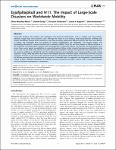Eyjafjallajökull and 9/11: The Impact of Large-Scale Disasters on Worldwide Mobility
Woolley-Meza, Olivia
Grady, Daniel
Thiemann, Christian
Bagrow, James P.
Brockmann, Dirk
Large-scale disasters that interfere with globalized socio-technical infrastructure, such as mobility and transportation networks, trigger high socio-economic costs. Although the origin of such events is often geographically confined, their impact reverberates through entire networks in ways that are poorly understood, difficult to assess, and even more difficult to predict. We investigate how the eruption of volcano Eyjafjallajökull, the September 11th terrorist attacks, and geographical disruptions in general interfere with worldwide mobility. To do this we track changes in effective distance in the worldwide air transportation network from the perspective of individual airports. We find that universal features exist across these events: airport susceptibilities to regional disruptions follow similar, strongly heterogeneous distributions that lack a scale. On the other hand, airports are more uniformly susceptible to attacks that target the most important hubs in the network, exhibiting a well-defined scale. The statistical behavior of susceptibility can be characterized by a single scaling exponent. Using scaling arguments that capture the interplay between individual airport characteristics and the structural properties of routes we can recover the exponent for all types of disruption. We find that the same mechanisms responsible for efficient passenger flow may also keep the system in a vulnerable state. Our approach can be applied to understand the impact of large, correlated disruptions in financial systems, ecosystems and other systems with a complex interaction structure between heterogeneous components.
Dateien zu dieser Publikation
Keine Lizenzangabe

